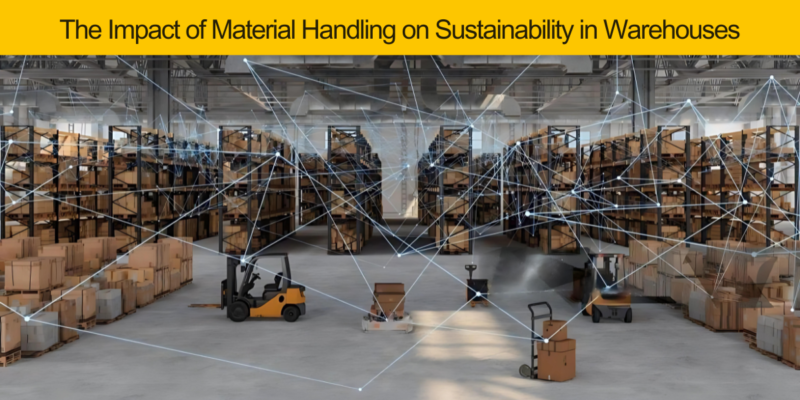As global businesses continue to shift towards more sustainable operations, warehouses and logistics centers are being scrutinized for their environmental footprint. Material handling, a core component of warehouse operations, plays a critical role in shaping sustainability outcomes.
Did you know that from the choice of material handling equipment to operational efficiency, every decision you make affects energy consumption, resource management, and your overall environmental performance? In this blog, let’s understand how that happens and what we can do about it.
Energy-Efficient Material Handling Equipment
One of the biggest contributors to warehouse sustainability is the adoption of energy-efficient material handling equipment. Warehouses traditionally relied on diesel-powered forklifts and other heavy machinery that contribute to greenhouse gas emissions. However, the industry has seen a shift towards electric and battery-operated equipment that offers cleaner energy alternatives.
For example, lithium-ion forklifts not only reduce emissions but also have a lower total cost of ownership due to their lower fuel and maintenance costs. Advanced lithium-ion batteries, with longer life cycles and faster charging capabilities, further enhance energy efficiency in material handling. These innovations allow warehouses to significantly reduce their carbon footprint while maintaining high levels of productivity.
The use of energy-efficient equipment is also supported by smart technologies that optimize performance. Modern forklifts, for instance, are equipped with advanced sensors and software to monitor fuel consumption and workload. By analyzing real-time data, warehouse managers can implement best practices for energy use, reducing wastage and unnecessary emissions.
Optimized Warehouse Layout and Automation
Another significant trend in sustainable material handling is the optimization of warehouse layouts and the integration of automation. Efficient warehouse design minimizes unnecessary movement of goods, reducing energy consumption and time. Compact material handling equipment like BOPT, Electric Stackers, and Reach Trucks are ideal for these layouts, as they can work efficiently in narrow aisles and tight vertical spaces, maximizing space utilization.
Automation has become a critical tool in making material handling more sustainable. Automated guided vehicles (AGVs), robotic systems, and automated conveyor belts are increasingly employed in warehouses to move goods efficiently and with minimal human intervention. These automated systems optimize energy use by reducing idle times and ensuring that equipment runs at peak efficiency. In the long term, automation can also reduce the need for additional equipment and labor, contributing to reduced energy consumption and fewer environmental impacts.
Safety and Ergonomics in Sustainable Material Handling
Beyond energy efficiency and layout optimization, safety and ergonomics play a crucial role in ensuring sustainability in warehouses. By reducing workplace accidents and promoting operator well-being, well-designed material handling equipment helps create a more sustainable work environment. Ergonomic features in electric forklifts and other modern equipment not only enhance worker safety but also contribute to long-term productivity and lower operational costs.
Recycling and Waste Reduction
The push for sustainability in warehouses also extends to waste management. Effective material handling practices can help reduce waste through recycling initiatives and efficient use of resources. Warehouses generate significant amounts of waste from packaging materials, damaged goods, and routine operations. However, with the right material handling practices, much of this waste can be minimized or recycled. For example, some warehouses are implementing “zero waste to landfill” initiatives, ensuring that all materials are either recycled or reused.
The Future of Sustainable Material Handling
As sustainability becomes a core focus for businesses worldwide, material handling will continue to evolve to meet these challenges. In the future, we can expect to see even greater integration of green technologies, such as hydrogen fuel cells for forklifts, solar-powered warehouses, and further advances in automation and artificial intelligence.
Governments and regulatory bodies are also pushing for stricter environmental standards, which will drive the adoption of sustainable material handling practices even further. For warehouses looking to stay competitive, adopting these trends early can not only improve their environmental impact but also lead to significant cost savings in energy, waste management, and equipment longevity.
Conclusion
Material handling is a critical element in any warehouse’s sustainability strategy. From energy-efficient equipment to optimized layouts, automated systems, and sustainable packaging, warehouses can significantly reduce their environmental footprint while boosting operational efficiency. As businesses continue to prioritize sustainability, the role of material handling in creating greener, more efficient warehouses will only grow in importance.
OM Material Handling, with its wide range of energy-efficient and eco-friendly equipment, is at the forefront of this green revolution. Investing in advanced material handling solutions can help businesses not only meet their sustainability goals but also improve their bottom line. Contact OM today to explore how their innovative products can contribute to a more sustainable future for your warehouse. Get in touch with us at 1800 270 1123 or visit www.om-mh.com to learn more and take the first step towards a more efficient future.


